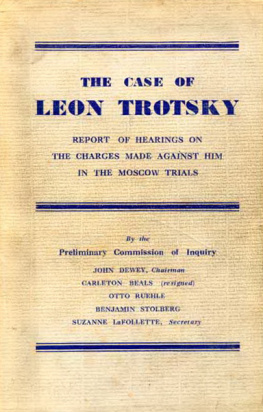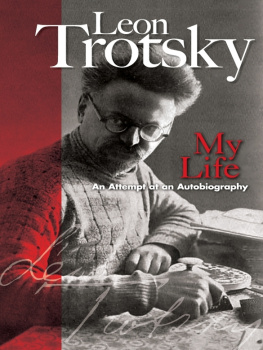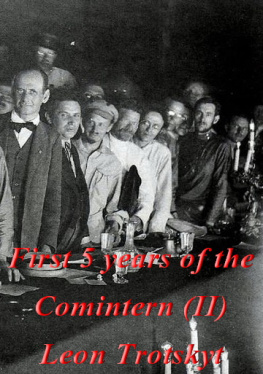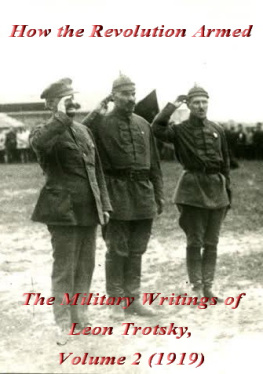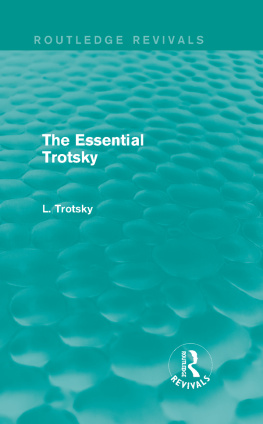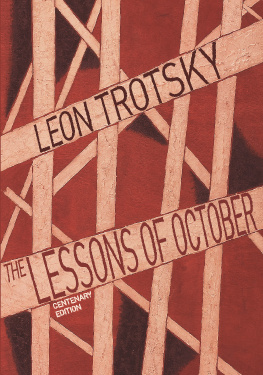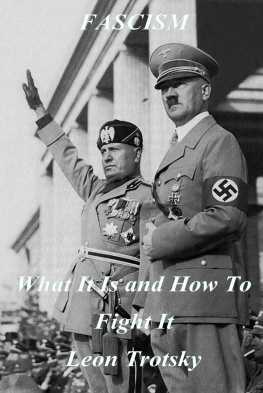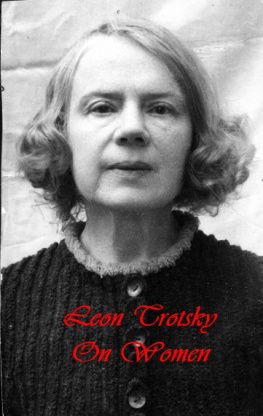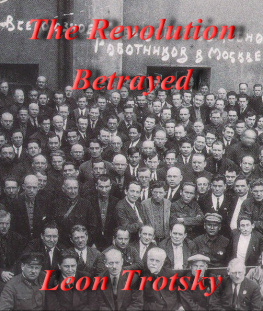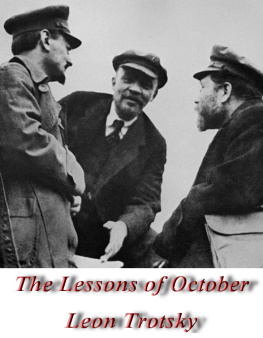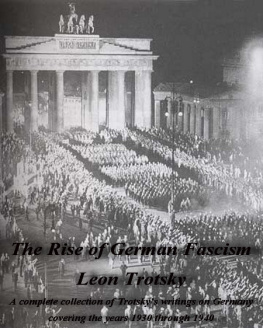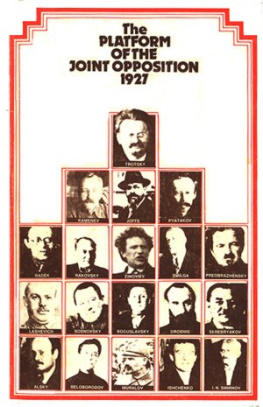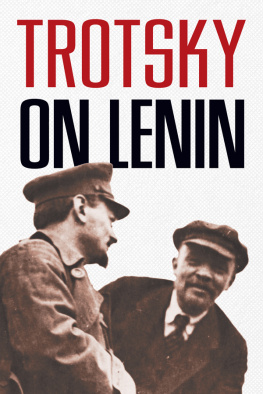Trotsky - Collected Writings on China
Here you can read online Trotsky - Collected Writings on China full text of the book (entire story) in english for free. Download pdf and epub, get meaning, cover and reviews about this ebook. year: 2014, genre: Romance novel. Description of the work, (preface) as well as reviews are available. Best literature library LitArk.com created for fans of good reading and offers a wide selection of genres:
Romance novel
Science fiction
Adventure
Detective
Science
History
Home and family
Prose
Art
Politics
Computer
Non-fiction
Religion
Business
Children
Humor
Choose a favorite category and find really read worthwhile books. Enjoy immersion in the world of imagination, feel the emotions of the characters or learn something new for yourself, make an fascinating discovery.
- Book:Collected Writings on China
- Author:
- Genre:
- Year:2014
- Rating:4 / 5
- Favourites:Add to favourites
- Your mark:
- 80
- 1
- 2
- 3
- 4
- 5
Collected Writings on China: summary, description and annotation
We offer to read an annotation, description, summary or preface (depends on what the author of the book "Collected Writings on China" wrote himself). If you haven't found the necessary information about the book — write in the comments, we will try to find it.
The online version of Leon Trotsky: Collected Writings on China also includes The Third International After Lenin. This work has been published as a separate ebook by Kollektiv Yakov Perelman and it is available from the Leon Trotsky eBook Library
Collected Writings on China — read online for free the complete book (whole text) full work
Below is the text of the book, divided by pages. System saving the place of the last page read, allows you to conveniently read the book "Collected Writings on China" online for free, without having to search again every time where you left off. Put a bookmark, and you can go to the page where you finished reading at any time.
Font size:
Interval:
Bookmark:
1927:
1927/1931: [Collection of writings published in 1932]
1928:
1929:
1932:
1932:
1933:
1937:
1938:
Converted to ebook format by Kollektiv Yakov Perelman from online versions available at Trotsky Internet Archive in January 2014.
The online version of Leon Trotsky: Collected Writings on China also includes The Third International After Lenin. This work has been published as a separate ebook by Kollektiv Yakov Perelman and it is available from the Leon Trotsky eBook Library
Written on April 3, 1927.
Published in New International [New York], Vol.IV No.3, March 1938, pp.87-89, and Vol.IV No.4, April 1938, pp.
Transcribed by Heiko Khoo in 1997 for the Chinese Marxism Archive as part of the Leon Trotsky On China page.
Additional HTML markup and editing for the by David Walters.
April 3, 1937
Issue 11 of the Communist International (March 18, 1927) printed as an editorial an article on the Fifth Congress of the Chinese CP and the Kuomintang which is in every way an exceptional mockery of the basic elements of Marxist theory and Bolshevik politics. This article cannot be characterized otherwise than as the worst expression of right Menshevism on questions of revolution.
As its starting point the article takes the proposition that the problem of problems of the Chinese revolution at the present moment is the position of the Kuomintang, the further development of the Kuomintang as a party at the head of the South China state (p.4). Thus the problem of problems is not the awakening and the unification of millions of workers under the leadership of trade unions and the Communist Party, nor the drawing of poor peasants and artisans into the mainstream of the movement, nor the deepening of the struggle of the CP to win over the proletariat, nor the struggle of the proletariat for influence over the many-millioned masses of the disinherited no, the problem of problems (!) is the position of the Kuomintang, i.e., a party organization which embraces, according to official figures, some 300,000 members students, intellectuals, liberal merchants in general, and in part peasants and workers.
For a political party, declares the article, 300,000 members is quite a considerable number. A paltry parliamentary appraisal! If these 300,000 had emanated from the experience of past class struggles, and the experience of leading proletarian strikes and peasant movements, then, naturally, even a smaller number of members could successfully assume the leadership of the revolution on its new and broader mass stage. But these 300,000 represent in their majority the result of individual recruitment among the tops. We have here the unification of national-liberals or Cadets with right SRs, with an admixture of young communists who are compelled in the period of their political training to submit to the discipline and even the ideology of a bourgeois-nationalist organization.
The development of the Kuomintang, continues the article, reveals alarming [!] symptoms from the standpoint of the interests of the Chinese revolution (p.4). And what is the nature of these alarming symptoms? Apparently it is this, that the power is in the hands of the Kuomintang center, and the center has in the recent period gravitated in most instances definitely to the right. It should be noted that all political definitions in this article are of a formal, parliamentary, and ceremonial character, emptied of all class content. What is the meaning of this gravitation-to the right? What kind of Kuomintang center is this? It consists of the tops of the petty-bourgeois intelligentsia, middle-ranking functionaries, and so on. Like all petty bourgeois, this center is incapable of carrying out an independent policy, especially in the period when millions of workers and peasants have entered the arena. This petty-bourgeois center can produce an ally for the proletariat only on the condition that the proletariat carries out an independent policy. But there cannot even be talk of such a policy in China in the absence of an independent class party there.
Communists do not simply join the Kuomintang but they submit to its discipline and even obligate themselves not to criticize Sun Yat-senism. Under these conditions, the petty-bourgeois intellectual center can only trail behind the nationalist-liberal bourgeoisie, which is bound up by imperceptible gradations with the compradorian, i.e., overtly imperialist bourgeoisie; and, in proportion as the struggle of the masses sharpens, go over openly to its side. Thus the Kuomintang is a party apparatus adapted for the political subjection of the mass movement through the medium of a top intellectual center to an out-and-out right, i.e., manifestly bourgeois leadership, which under these conditions unfailingly subjects the Nationalist government to itself, and will continue to do so. The article cites the fact that lefts predominate in conferences, congresses, and the Executive Committee of the Kuomintang, but that this solacing circumstance is not reflected in the composition and politics of the Nationalist government. How astonishing! But, after all, the left petty bourgeoisie exists only to display its radicalism in articles, and at conferences and banquets, while handing the power over to the middle and big bourgeoisie.
Thus the alarming symptoms in the Kuomintang consist in this, that the Kuomintang does not personify the pure idea of a national liberation revolution, which the author of the article sucked out of his thumb, but rather reflects the class mechanics of the Chinese revolution. The author finds alarming the fact that the history of the Chinese people is unfolding in the form of a class struggle, proving thereby no exception to the history of all mankind. The article further informs us that the Kuomintang and the Nationalist government are seriously concerned [a remarkable expression!] about the growth of the labor movement. What does this mean? It only means that the intellectual petty bourgeoisie has become scared by fear of the bourgeoisie before the awakening of the working masses. In proportion as the revolution extends and deepens its base, radicalizes its methods, sharpens its slogans, groups and layers of proprietors and intellectual burghers bound up with them will inevitably split from it at the top.
One part of the national government is joined with blood-ties to the bourgeoisie, and another part, fearful of breaking with it, becomes concerned about the growth of the labor movement, and seeks to harness the latter. By this delicate expression, concerned, as previously by the words alarming symptoms, the article refers to the sharpening of class relations, and to the attempts of the nationalist-liberal bourgeoisie, by using the Kuomintang as a tool and by issuing orders through it to the Nationalist government, to place a halter on the proletariat. When and where have we ever appraised class relations as is done by the lead article in the Communist International? Whence come these ideas? What is their source?
What methods are proposed in the article to overcome these alarming symptoms? On these questions the article polemicizes against the June (1926) plenum of the Central Committee of the Chinese CP, which adopted the position that it was necessary for the CP as an independent organization to conclude a bloc with the Kuomintang. The article rejects this idea. It also rejects the proposal to organize a left faction in the Kuomintang as an ally of the CP. No, the task it teaches consists in assuring a firm left orientation to the whole Kuomintang. The question is solved easily. What is needed at the new stage of development, at a time when the workers are engaging in strikes against the capitalists, when the peasants are seeking, against the opposition of the Nationalist government, to drive out the landlords-what is needed at this new stage is to assure a firm left orientation to the Kuomintang, which represents the unification of a section of the bourgeoisie suffering from the strikes, a section of the landed intelligentsia suffering from the agrarian movement, the urban petty-bourgeois intellectuals who are fearful of repelling the bourgeoisie to the side of reaction, and finally the Communist Party which is bound hand and foot. It is this Kuomintang which must acquire a firm left orientation.
Font size:
Interval:
Bookmark:
Similar books «Collected Writings on China»
Look at similar books to Collected Writings on China. We have selected literature similar in name and meaning in the hope of providing readers with more options to find new, interesting, not yet read works.
Discussion, reviews of the book Collected Writings on China and just readers' own opinions. Leave your comments, write what you think about the work, its meaning or the main characters. Specify what exactly you liked and what you didn't like, and why you think so.


